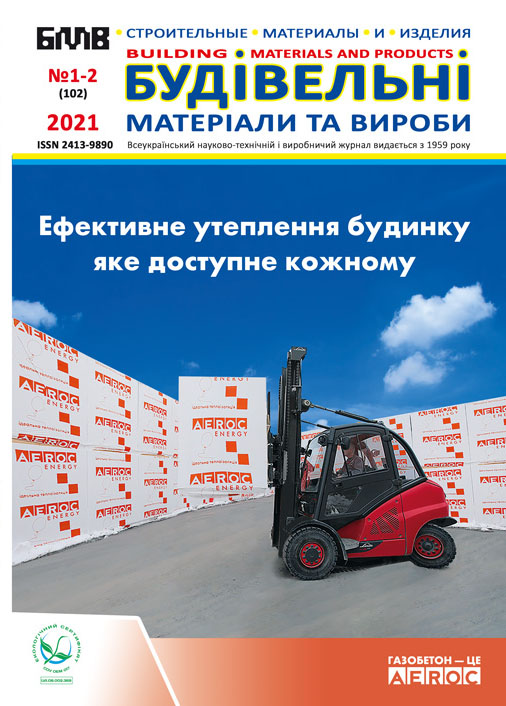ШЛЯХИ ЕНЕРГОЗБЕРЕЖЕННЯ ПРИ ВИКОРИСТАННІ ТА ВИРОБНИЦТВІ ГАЗОБЕТОНУ НИЗКОЇ ЩІЛЬНОСТІ
DOI:
https://doi.org/10.48076/2413-9890.2021-102-01Ключові слова:
стеновые материалы, энергоэффективность газобетон, теплоизоляцияАнотація
В статье приведен анализ нормативных требований, касающихся термического сопротивления стен современных зданий. Сравнение нормативных требований близких к Украине по климатическим условиям стран Балтии и Финляндии свидетельствует о значительном отставании показателей украинских нормативов. На основе анализа структуры стеновых материалов, производимых в Украине, показано снижение объемов производства керамического строительного кирпича, керамзита, которые потеряли свои позиции на строительном рынке из-за высокой энергоёмкости производства и низких теплофизических свойств на стадии эксплуатации и были вытеснения автоклавным газобетоном.Показаны тенденции производства автоклавного газобетона в Украине. Высокий уровень технологии производства отечественного газобетона подтверждается качеством продукции компании «Аэрок», которая занимает ключевые показатели по производству автоклавного газобетона низкой плотности и высокой прочности. Компания первой на территории постсоветского пространства начала массовое производство теплоизоляционного газобетона марки D150, не имеющего аналогов в СНГ, и газобетона марки D300 с классом прочности на сжатие С2,0. Показана структура производства газобетона по плотности компании «Аэрок» и основные направления снижение расхода цемента при производстве газобетона за счет использования доменного гранулированного шлака и природного гипсового камня. Приведена зависимость увеличения расхода цемента в зависимости от снижения плотности газобетона.Раскрыты особенности совершенствования качества автоклавного газобетона на примере продукции компании «Аэрок» и показаны пути повышениякарбонизационной стойкости автоклавного газобетона из-за низкой плотности и высокой паропроницаемости.Metrics
Посилання
ДБН В.2.6-31:2016. Теплова ізоляція будівель. – Київ, Мінрегіонбуд України. – 2017. – 37 с.
Кафтаева М.В., Рахимбаев И.Ш Тепловыделение при синтезе гидросиликатной святки автоклавного газобетона/ Междуна- родный журнал прикладных и фундаментальных исследований. №10, 2013-С.373-376.
Инструкция по изготовлению изделий из ячеистого бетона (СН 277-80). Госстрой СССР. М. Стройиздат. 1981. 46с.
Рудченко Д.Г., Дюжилова Н.О, Сердюк В.Р. Оцінка можливості застосування доменних гранульованих шлаків в технології ви- робництва автоклавного газобетону. Вісник ОДАБА. Випуск №79. 2020. –С.117-126.
Кудеярова Н.П., Ожерельева А.Ю. Влияние добавки гипса на качество композиционного вяжущего для изделий ячеистой структуры // Вестник БГТУ им. В.Г. Шухова. 2019. № 6. С. 96–101.
Аниканова Т.В., Рахимбаев Ш.М., Кафтаева М.В. К вопросу о механизме углекислотной коррозии строительных материалов
// Фундаментальные исследования. – 2015.– № 5-1. – С. 19-26.
Штарк Й., Бернд В. Цемент и известь / Пер. с нем. А. Тулаганова под ред. П. Кривенко. – К.: Оранта, 2008. – 480с.
Легостаева Н. В.,Нестерова Т. Ю. Механические свойства газобетона с добавками шлама карбоната кальция. Вестник ТГАСУ
№ 1, 2017. –С.155-161.
Божок Е.В., Вольф А.В. Маноха А.М. Козлова В.К. Пути снижения усадочных деформаций при твердении и службе газобетона. Ползуновский весник. № 2. 2017. –С.105-109.
Воробьев А.А., Елфимов В.И. Влияние карбонатных добавок на долговечность ячеистых бетонов. Весник РУДН, сер. Инже- нерные исследования, 2001, №1,-С.86-89.
Рудченко Д. Г. Теоретические предпосылки использования комплексной активной минеральной добавки в технологии автоклавного газобетона. Збіник наукових праць. Науковий вісник будівництва, ХНУБА. 2020, т. 100, №2. – С.201-209.
Опубліковано
Як цитувати
Номер
Розділ
Ліцензія
Авторське право (c) 2021 Автори

Ця робота ліцензується відповідно до Creative Commons Attribution 4.0 International License.




